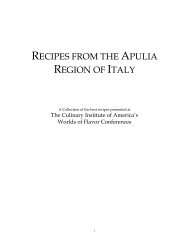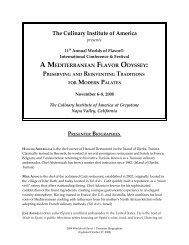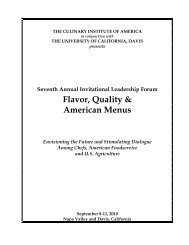Authentic Flavors for American Menus - CIAProChef.com
Authentic Flavors for American Menus - CIAProChef.com
Authentic Flavors for American Menus - CIAProChef.com
You also want an ePaper? Increase the reach of your titles
YUMPU automatically turns print PDFs into web optimized ePapers that Google loves.
it just after removing a curry from the heat. Always buy it fresh, not dried, and use the leaves and tender stems<br />
<strong>for</strong> cooking. In Kerala it is primarily used in Muslim cooking. (MK)<br />
Coriander Seeds, Whole and Ground (Dhania, Sabut and Pisa) These are the round, beige seeds of the<br />
coriander plant. You may buy them already ground or you can buy whole seeds, and grind them yourself in<br />
small quantities in an electric coffee grinder. I like to put my home-ground coriander seeds through a sieve but<br />
this is not essential.<br />
Ground coriander seeds, if stored <strong>for</strong> long, begin to taste a bit like sawdust. It is best at this stage to discard them<br />
and start with a fresh batch. (MJ)<br />
Coriander and Cumin Seed Mixture, Ground (Dhana Jeera Powder) This <strong>com</strong>bination of roasted and ground<br />
coriander and cumin seeds, in the proportion of 4 parts to 1 part, is used in Gujarat and Maharashtra. To make it,<br />
put 4 tablespoons/60 ml/ l/3 cup of whole coriander seeds and l tablespoon /15 ml of whole cumin seeds into a<br />
small cast-iron frying pan and place the pan over a medium flame. Stir the seeds and keep roasting them until<br />
they turn a few shades darker. Let the seeds cool somewhat. Put the seeds into the container of a coffee grinder<br />
or other spice grinder and grind as finely as possible. Store in an airtight container. (MJ)<br />
Cream of Rice (idli rava) A coarsely ground rice product called idli rava in India offers a short-cut to grinding<br />
rice from scratch. The breakfast cereal called Cream of Rice is essentially the same, so it makes a perfect<br />
substitute. (MK)<br />
Cumin Seeds, Whole and Ground (Zeera, Sabut and Pisa) Whole seeds keep their flavour well and may be<br />
ground very easily in an electric coffee grinder when needed. You may also buy the seeds in their ground <strong>for</strong>m.<br />
(MJ)<br />
Cumin is like the bass note of Indian cooking: it provides an indispensable layer of flavor, especially in vegetable<br />
curries. Pre-ground cumin is used most often in Kerala, but occasionally the seeds, resembling caraway seeds,<br />
are dropped into hot oil to flavor it <strong>for</strong> a stir-fry. It’s useful to have both whole seeds and ground cumin on hand.<br />
The ground cumin sold through Indian grocery stores and mail-order sources has a high turnover and so tends<br />
to be fresher than what is sold in supermarkets. But if you prefer to grind your own cumin with a mortar and<br />
pestle, be sure to use only two thirds of the amount called <strong>for</strong> in the recipe because the taste will be stronger.<br />
(MK)<br />
Cumin Seeds, Roasted and Ground (Bhuna Hua Zeera) Put 4-5 tablespoons/60-75 ml of whole cumin seeds into<br />
a small cast-iron frying pan and place the pan over a medium flame. Stir the seeds and keep roasting them until<br />
they turn a few shades darker. Let the seeds cool somewhat. Put the seeds into the container of a coffee grinder<br />
or other spice grinder and grind as finely as possible. Store in an airtight container. (MJ)<br />
Cumin Seeds, Black (Shah Zeera, Siyah Zeera or Kala Zeera) A caraway-like seed with a flavor that is more<br />
refined and <strong>com</strong>plex than that of the ordinary cumin. As it is expensive, it is used in small quantities. If you<br />
cannot find it, use regular cumin seeds as a substitute. (MJ)<br />
Curry Leaves, (Kari Leaves) Fresh and Dried (Kari Patta) The highly aromatic curry leaves are shaped rather<br />
like bay leaves and are sold in India while still attached to their stems. Indian housewives and cooks use them<br />
only when they are fresh, pulling them off their stems just be<strong>for</strong>e they throw them into the pot. Only the dried<br />
leaves are available in most Western cities though I notice that some grocers in Great Britain are now beginning<br />
to import them, fresh and on the stem, from Africa. There are sections of India, such as the South, where curry<br />
leaves flavour more than half the dishes. Use the fresh leaves whenever you can find them—otherwise resort to<br />
the less flavourful dried ones. (MJ)<br />
This fragrant herb is a signature flavor in the cooking of Kerala. It has no relationship to the mixture of ground<br />
spices called curry powder, except that both <strong>com</strong>e from the Anglicized version of the Tamil word kari, or sauce.<br />
The taste falls somewhere between green bell peppers and citrus peel, but like cilantro, the flavor is fleeting.<br />
Ways to capture its essence include sizzling the leaves in hot oil (the tarka method) and adding them at the last<br />
stage of cooking. There are roughly twenty flat leaves attached to each stem, and the leaves are stripped off the<br />
stem much like thyme. Fresh curry leaves, sold at Indian and Asian markets, are the most flavorful <strong>for</strong>m by far,<br />
and I have discovered how to keep them fresh and green <strong>for</strong> up to 6 weeks: Remove them from their plastic bag;<br />
pat them dry of any moisture; place them in between dry paper towels; store them in a large airtight Ziploc bag<br />
48<br />
WORLDS OF FLAVOR CONFERENCE AND FESTIVAL V1.1 THE CULINARY INSTITUTE OF AMERICA ®<br />
SAVORING ASIA—AUTHENTIC FLAVORS FOR AMERICAN MENUS










